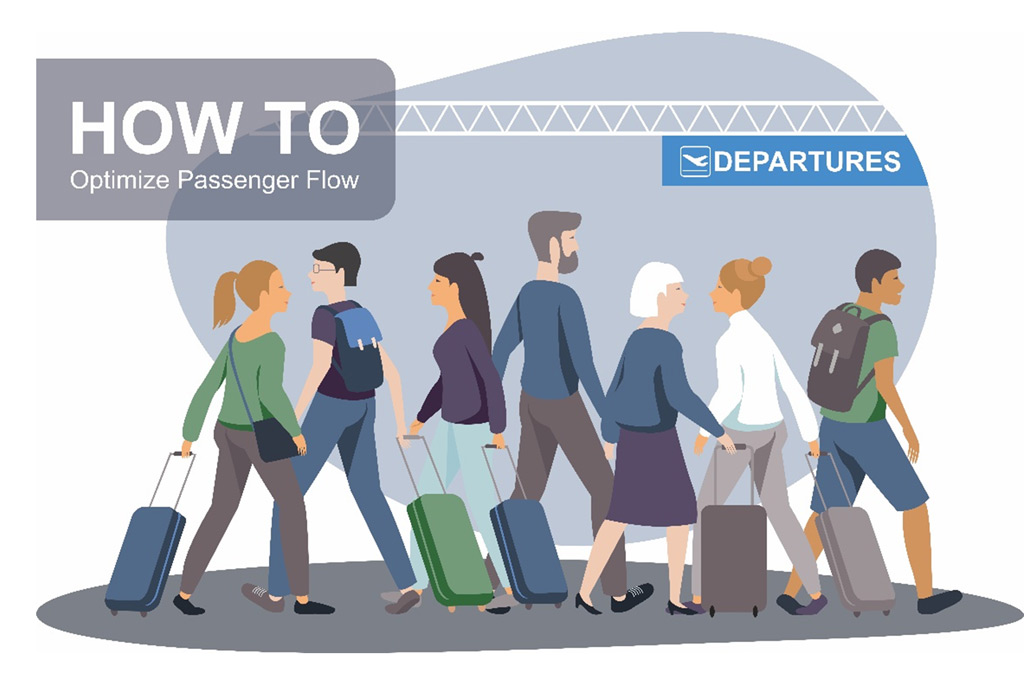The covid pandemic has been a major challenge for many companies in recent years. Even in 2022 long waiting times in airports and inefficient queues are the norm, especially since airports need more document checks and suffer from staff shortages as many employees have sought new jobs during lockdowns.
As a result, more and more airports are planning to install and use self-service solutions, such as self bag drop (SBD) and self-check-in. The aim is to optimize passenger processes at the airport, prevent waiting times, reduce costs and increase customer satisfaction.
For the calculation of an optimal number of devices and the optimal arrangement of kiosks and SBD solutions, an analysis of the passenger flow and individual concepts should be considered. Modern AI-based software can be used to simulate the passenger flow in advance and get the most out of given infrastructural conditions.
Based on our project experience, we have derived a 6-step-procedure for effective reorganization and improvement of airport processes.
Step 1 – Kick-off workshop
Investing in automated passenger solutions can generate many advantages for airports, like reduced running costs, less risks of staff bottlenecks, optimized process times, increased capacities and maximized efficiency.
But to make that happen, the concept has to fit the airport’s needs and future plans. Thus it is necessary to clarify general questions and given conditions in the initiation phase, most efficiently in a kick-off workshop. Within this workshop the involved parties should also discuss potential future scenarios and growth visions of the airport.
- What passenger numbers are expected in a mid and long term future?
- Are there plans to change the airport’s spatial capacities, e.g. by adding more terminals?
- Which airlines should be considered to simulate the current and future passenger flow?
Step 2 – Data Analytics
The second phase of the project is very crucial. Only with valid input data is it possible to simulate the passenger flow realistically. In this project phase, close collaboration is required and coordination with the airport is indispensable.
Of particular importance are the data on arrival times of different passenger types at the departure terminal (considering that an extended family usually arrives at the terminal earlier than a business traveler). In addition, data about a typical flight day, failure rates of kiosks, opening hours of check-in stations or the modeling of the check-in process complete the data basis for an accurate passenger flow simulation.
Data that is not yet available must either be collected or estimated. For this purpose, benchmarking data can be used or key assumptions can be made with the experience that Materna IPS has gained within its many international projects.
Step 3 – AI Process Modelling
In the third step, the different scenarios are simulated. For the calculation of the optimal number of kiosks, for example, it is relevant how much waiting time at the kiosks an airport tolerates as a maximum KPI. Once the optimal number of kiosks has been determined under this premise, different locations of the kiosks are analyzed. This analysis mainly includes the density of passengers (how many passengers are in the same place at the same time) as well as the distances passengers have to travel for the scenario. If both values were determined for all scenarios, one of them is already turning out to be a favorite.
Step 4 – Strategy Concept
All results are documented in a strategy concept. Other aspects are also analyzed in more detail here, such as the existing infrastructure at the airport, the necessary signage or the use of floorwalkers, the integration of additional airlines in the future, or potential expansions.
Once the airport has received the strategy concept, the tendering phase can begin and a suitable provider can be sought.
Step 5 – Implementation Plan
The implementation plan includes all necessary steps for the hardware and software rollout. This involves the procurement of the hardware, the development of the software, testing activities, the delivery to the client, the installation, different on-site tests, the baggage belt integration and much more. Only with a clean implementation planning in financial and time perspective the project will be successful.
Step 6 – Realization
The realization of the actions planned in phase 5 takes place in this project step and is completed as soon as the hardware and software are fully built and ready for operation and, to that extent, handed over to operations and tracking.
With an acceptance protocol, the equipment officially becomes the property of the airport at the end of the project. The operation of the software and the maintenance of the hardware can be taken over by the provider. Appropriate service contracts are concluded for this purpose.




